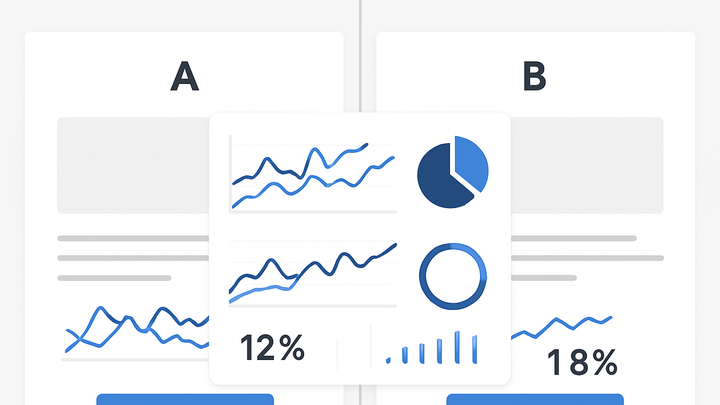Published on 2025-06-28T08:23:08Z
What is Experimentation in Analytics? Examples and Best Practices
Experimentation in analytics refers to the systematic process of testing changes to digital experiences—such as websites, mobile apps, or marketing campaigns—to measure their impact on key performance indicators (KPIs).
By running controlled tests like A/B or multivariate experiments, teams can validate hypotheses, optimize user journeys, and make data-driven decisions.
Tools like Google Analytics 4 (GA4) Experiments and PlainSignal’s cookie-free analytics enable seamless setup, tracking, and analysis of variant performance.
Experimentation reduces risk by identifying winning variations before a full rollout and fosters a culture of continuous improvement through iterative testing.
Whether you’re improving conversion rates, engagement, or other critical metrics, experimentation is essential for unlocking insights and driving sustainable growth.
Experimentation
Structured testing of website or app changes to measure impact on KPIs and optimize performance through data-driven insights.
Why Experimentation Matters
Experimentation allows teams to validate assumptions and optimize digital experiences through measurable outcomes. Instead of relying on guesswork, teams can use experiments to uncover which changes improve user engagement, conversions, or revenue. By testing hypotheses under controlled conditions, organizations reduce risk and achieve continuous improvement. Tools like GA4 and PlainSignal facilitate this by tracking variant performance and providing actionable insights.
-
Data-driven decision making
Experimentation replaces subjective opinions with objective data, supporting decisions backed by metrics.
-
Eliminating bias
Randomized experiments remove personal or organizational biases by evenly distributing traffic across variants.
-
Objective validation
Statistical analysis shows clear winners, validating hypotheses with confidence intervals.
-
-
Risk mitigation
Testing changes on a subset of users limits potential negative impacts before rolling out widely.
Types of Experiments
There are several experimentation methods suited for different goals and complexity levels. Choosing the right type ensures you can detect meaningful effects and act on results effectively.
-
A/b testing
Compares two versions of a page or feature (A vs. B) to determine which performs better on a key metric.
-
Multivariate testing
Tests multiple elements and their combinations simultaneously to identify the most effective variations.
-
Split url testing
Hosts different variants on separate URLs, useful when significant layout changes are needed.
-
Bandit testing
Allocates more traffic to higher-performing variants in real time, optimizing for conversions while experimenting.
Setting Up an Experiment
A well-designed experiment follows a structured process: define a clear hypothesis, select relevant metrics, implement variants, and configure tracking. Leveraging analytics platforms like GA4 and PlainSignal streamlines setup and data collection.
-
Define hypothesis and metrics
Start with a specific, testable hypothesis and decide on primary and secondary metrics (e.g., conversion rate, bounce rate).
-
Smart goals
Ensure objectives are Specific, Measurable, Achievable, Relevant, and Time-bound.
-
-
Implement variants
Create the variant designs in your platform of choice and integrate tracking code to differentiate traffic groups.
-
Using GA4
Set up an experiment via GA4’s Content Experiments or through Google Optimize integration, and install the GA4 tracking snippet.
-
Using PlainSignal
Add the following snippet to your pages to enable variant tracking:
<link rel="preconnect" href="//eu.plainsignal.com/" crossorigin /> <script defer data-do="yourwebsitedomain.com" data-id="0GQV1xmtzQQ" data-api="//eu.plainsignal.com" src="//cdn.plainsignal.com/plainsignal-min.js"></script>
-
-
Randomization and traffic allocation
Ensure users are randomly assigned to variants with balanced traffic distribution to avoid skewed results.
Analyzing Experiment Results
After running the experiment, interpret the data to decide whether to adopt, modify, or discard the tested changes. Focus on statistical rigor and context.
-
Statistical significance
Use p-values and confidence intervals to determine if observed differences are unlikely due to chance.
-
Duration and sample size
Calculate required sample sizes to reach valid conclusions and avoid stopping tests prematurely.
-
Segment analysis
Break down results by user segments (e.g., device, location) to uncover differential impacts.
Best Practices for Experimentation
Following best practices helps ensure reliable, actionable results and avoids common pitfalls.
-
Test one change at a time
Isolate variables to attribute impacts accurately.
-
Avoid peeking at data
Refrain from checking results mid-test to prevent false positives from early fluctuations.
-
Document and share findings
Record hypotheses, setup, results, and learnings to foster continuous improvement.
